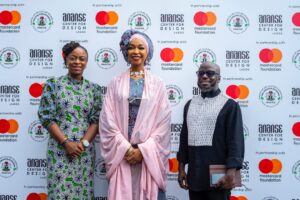By Enam Obiosio
Framing the Story through the IR Lens
At first glance, the unveiling of the Ananse Centre for Design Lagos looks like a creative sector development milestone – a win for fashion, youth, and innovation. But beneath the surface, this event represents a deeper investment relations narrative: one that combines public-private partnership (PPP), sustainability alignment, and capital-readiness positioning within Nigeria’s evolving creative economy.
Investor relations – traditionally associated with listed companies – now increasingly extends into the creative and SME ecosystem, where structured communication, governance, and visibility determine who attracts funding and who remains on the margins. In that light, Ananse’s partnership with the Mastercard Foundation and endorsement by the Federal Ministry of Art, Culture and Creative Economy mark a textbook example of how IR principles can drive credibility, investor confidence, and sectoral capital formation. To discover how to build the Nigerian Creative Economy through IR, CLICK: http://building-nigerias-creative-future-through-investor-relations/
The Ananse Centre as a Structured Investor-Readiness Platform
From an IR perspective, the Ananse Centre for Design is not just a training hub – it is an infrastructure for capital absorption. Its three core components – skills training, access to infrastructure, and access to markets – mirror the classic IR framework of capacity, governance, and disclosure that underpins investor confidence.
In practice:
- Skills and training build human capital – the creative workforce becomes investment-grade.
- Infrastructure provides operational legitimacy – investors see physical proof of commitment and scale.
- Market access provides liquidity – the creative outputs can now circulate within structured domestic and international markets.
These are the same fundamentals that IR professionals use to assess a listed firm’s investment readiness. In this case, Ananse is applying that framework to fashion entrepreneurship, effectively building the foundation for creative SMEs to become investor-attractive.
Public-Private Partnership as an Investor Relations Signal
The partnership between Ananse, the Mastercard Foundation, and the Federal Ministry is a strong IR signal – it communicates alignment with both developmental finance priorities and national economic goals. The involvement of a respected international financier (Mastercard Foundation) automatically raises the governance bar and de-risks perception for potential investors looking to enter Nigeria’s creative economy. Take a LOOK at How Nigeria’s Creative Economy is becoming Nigeria’s Next Investment gold mine: https://stakebridgeirpr.com/media/2025/10/21/nigerias-creative-economy-the-next-investment-goldmine/
From an IR standpoint, this collaboration achieves three critical outcomes:
- Validation: The Mastercard Foundation’s participation functions as third-party endorsement – the equivalent of a “credit rating” for credibility.
- Policy Assurance: The Ministry’s endorsement and five-year MoU provide regulatory continuity, which is essential for long-term investors seeking policy stability.
- Impact Positioning: The focus on women and youth aligns with global ESG (Environmental, Social, Governance) investment priorities – an increasingly dominant lens for fund managers.
This triple alignment (private initiative + development partner + government policy) is exactly the kind of multi-stakeholder IR model that Nigeria needs to attract global impact capital.
The Gender and Youth Focus: ESG as a Core IR Narrative
Modern investor relations goes beyond profit communication; it integrates sustainability and inclusion into the investment story. The Ananse project’s design – targeting 70% young women and linking 50,000 job opportunities – directly embeds social performance metrics into its communications.
This means Ananse isn’t just reporting on economic outputs (training numbers, design showcases), but on social returns – a critical component for attracting:
- Impact investors
- Development finance institutions (DFIs)
- ESG-driven venture funds
Nigeria’s IR practitioners should pay attention to this model: it shows how creative projects can become compliant with global ESG reporting standards, making them eligible for long-term, concessional, and blended financing instruments.
The Federal Ministry’s MoU: Institutionalising Creative IR
The Federal Ministry of Art, Culture and Creative Economy’s five-year MoU with Ananse is a strong IR communication move. It provides policy continuity, which helps convert creative development efforts into bankable national programmes.
From the IR angle, such government endorsement:
- Provides narrative stability for foreign partners.
- Serves as risk mitigation for capital inflows.
- Signals that Nigeria is serious about institutionalising the creative economy as an economic growth pillar.
Minister Hannatu Musa Musawa’s framing of the project – “investing in skills, facilities and global visibility for our designers” – mirrors the IR vocabulary of investment in capacity, infrastructure, and visibility. In effect, the Ministry is adopting an IR-style narrative to communicate national value creation to both domestic and international investors.
This approach is significant: it signals the birth of what could become a Creative Economy Investor Relations Framework – one that combines storytelling, measurable impact, and transparent partnership reporting.
Beyond Fashion: Building Creative Capital Markets
In IR practice, every thriving sector eventually seeks formal market integration. What Ananse has done here is lay the groundwork for the financialisation of the creative sector – i.e., the point at which creative outputs become tradeable, investible, and insurable assets.
The Centre’s focus on design and entrepreneurship offers the potential to:
- Develop creative micro-enterprises that can graduate into capital market issuers on platforms like NASD.
- Create Creative Sector Funds or Impact Bonds backed by measurable training and job creation outcomes.
- Enable crowdfunding compliance under SEC regulations, giving investors structured access to creative ventures.
In this context, the Ananse Centre can evolve into a pipeline of investor-ready enterprises – a feeder ecosystem for creative startups to access blended finance, venture funding, or even securitised instruments.
That is the ultimate investor relations outcome: turning creative passion into structured capital flow.

L-R: Rosy Fynn, Country Director, Mastercard Foundation; Mrs. Hannatu Musa Musawa, Honourable Minister of Art, Culture, Tourism and Creative Economy, and Sam Mensah, Chief Executive Officer/Founder of Ananse Centre for Design, Lagos, during the inauguration of the Centre for Design in Lagos recently.
Mastercard Foundation’s Role: Building Credibility through Global IR Standards
For IR professionals, the Mastercard Foundation’s involvement represents a masterclass in strategic disclosure and partnership management. The Foundation’s Country Director, Rosy Fynn, explicitly framed the collaboration as an impact investment in youth and gender inclusion – a narrative that meets international reporting benchmarks like:
- IFC Performance Standards
- Global Impact Investing Network (GIIN) Metrics
- UN SDG alignment
By embedding these into the communication of the project, Mastercard effectively positions the Centre within the global sustainable investment ecosystem, ensuring visibility among international capital allocators who prioritise measurable social outcomes.
Nigeria’s IR ecosystem should draw lessons here: global capital responds best to structured impact stories backed by credible partners and transparent metrics.
Integrating the Creative Economy into Nigeria’s IR Strategy
The Nigerian investor relations community – spanning regulators, capital market operators, and communication professionals – can leverage this model to mainstream the creative economy within the broader national investor narrative.
Key actions include:
- Developing Creative Economy Investor Factbooks showcasing sector opportunities, data, and growth potential.
- Hosting Investor Roadshows that feature creative enterprises alongside tech and manufacturing startups.
- Encouraging state governments to adopt IR-style communication for creative clusters – highlighting ROI, ESG benefits, and partnership pipelines.
By integrating these into national IR campaigns (for instance, through SEC, NASD, or SMEDAN collaborations), Nigeria can position the creative sector as a non-traditional but high-yield investment domain.
Lessons for Investor Relations Practice
From this event, IR experts can extract several insights:
- Visibility is Value: The physical existence of the Ananse Centre communicates commitment and continuity – key IR signals for investor confidence.
- Partnership is Proof: The presence of Mastercard and government endorsement enhances governance perception – the IR equivalent of audited credibility.
- Narrative is Capital: The project’s framing – women, youth, sustainability – transforms it into a globally relatable investment story.
- Scalability is Security: The MoU ensures long-term program continuity, which institutional investors interpret as a de-risking mechanism.
These are the same fundamentals that drive listed entities – and when applied to creative and social enterprises, they can unlock massive flows of patient capital.
The Broader IR Message
Ultimately, the launch of the Ananse Centre for Design Lagos embodies a simple truth at the heart of investor relations: capital follows credibility, and credibility follows communication.
Through transparent partnerships, inclusive design, and measurable outcomes, the Centre demonstrates how creative enterprises can transition from passion-driven ventures to investment-grade ecosystems.
For Nigeria’s investor relations community, this is a clear directive – to widen the IR lens beyond traditional financial sectors and actively support emerging industries like fashion, design, and creative technology as credible investment frontiers.
When creativity meets structure, and storytelling meets strategy, investor confidence naturally follows.
That is the future of investor relations – and Nigeria’s creative economy is proving to be its most promising canvas yet.
Discover more from StakeBridge Media
Subscribe to get the latest posts sent to your email.

